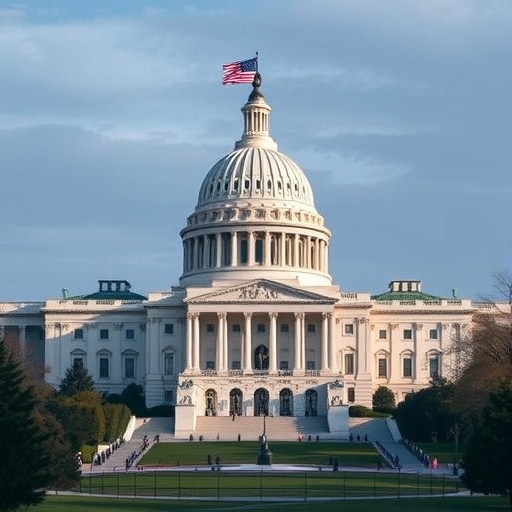2025 Government shutdown Surpasses 1996 Record: Second-Longest in U.S. History Amid Deepening Budget Impasse
In a stark reminder of the fragility of U.S. politics, the 2025 federal Government shutdown has officially eclipsed the 21-day closure during President Bill Clinton’s administration in 1995-1996, cementing its place as the second-longest in American history as of October 21, 2025. Now stretching into its 22nd day, this Government shutdown—triggered by a persistent budget impasse in Congress—has left hundreds of thousands of federal employees in limbo, disrupted vital services, and rattled the national economy. With no resolution in sight, lawmakers from both parties are digging in, raising fears of an even more protracted standoff that could rival the record 35-day shutdown of 2018-2019.
- Historical Parallels: How the 2025 Shutdown Outlasts Clinton-Era Standoff
- Economic Ripples: Billions Lost as Federal Services Grind to a Halt
- Partisan Finger-Pointing: Congress Deadlocked Over Core Spending Disputes
- Human Stories Emerge: Federal Workers and Communities Feel the Squeeze
- Path Forward: Bipartisan Talks Heat Up as Shutdown Risks Escalate
The shutdown began on October 1, 2025, when Congress failed to pass a stopgap funding bill amid disagreements over spending priorities, including defense allocations, social welfare programs, and infrastructure investments. As the clock ticked past midnight on October 21, the impasse had already cost the economy billions, according to preliminary estimates from the Congressional Budget Office (CBO). This milestone not only underscores the deepening divisions in U.S. politics but also highlights the human toll on everyday Americans reliant on the federal government‘s operations.
Historical Parallels: How the 2025 Shutdown Outlasts Clinton-Era Standoff
To understand the gravity of this moment, it’s essential to revisit the annals of government shutdown history. The 1995-1996 shutdowns, which totaled 21 days across two separate events, were born from a similar budget impasse between a Republican-led Congress and Democratic President Clinton. At the time, fiscal conservatives pushed for deep spending cuts, leading to closures that furloughed 800,000 federal workers and halted services like national park operations and passport processing. That era’s shutdown ended with a compromise, but not without public backlash that influenced the 1996 elections.
Fast-forward to 2025, and the current government shutdown has already surpassed that mark, affecting over 2.1 million federal employees—more than double the number from nearly three decades ago, adjusted for workforce growth. According to a report from the Office of Personnel Management (OPM), approximately 800,000 workers are currently furloughed without pay, while another 1.3 million are working without compensation, relying on the promise of retroactive pay once the crisis resolves. This escalation in scale reflects the expanded footprint of the modern federal government, which now oversees everything from cybersecurity to pandemic preparedness.
Experts point to recurring themes in these crises. Dr. Elena Ramirez, a political historian at Georgetown University, notes, “The 2025 shutdown mirrors the 1990s in its partisan roots, but the stakes are higher today due to our polarized U.S. politics. Back then, shutdowns were novel; now, they’re a dreaded ritual.” Historical data from the Pew Research Center shows that since 1976, the federal government has faced 20 partial shutdowns, with durations averaging just five days—making this one an outlier that demands urgent attention from Congress.
Comparatively, the longest shutdown remains the 2018-2019 event under President Trump, which lasted 35 days over border wall funding. If the current impasse persists, projections from the Bipartisan Policy Center suggest it could approach that record by mid-November, potentially costing the U.S. economy up to $1.5 billion per week in lost productivity and delayed services.
Economic Ripples: Billions Lost as Federal Services Grind to a Halt
The financial fallout from this government shutdown is mounting rapidly, with ripple effects felt far beyond Washington’s Beltway. The CBO estimates that as of October 21, the shutdown has already drained $18 billion from the national economy, including $6 billion in direct losses from furloughed workers and an additional $12 billion in indirect impacts like reduced consumer spending and delayed government contracts. Small businesses near federal installations, such as those in Virginia and Maryland, are particularly hard-hit, with tourism and vendor revenues plummeting by 40% in the first three weeks, per data from the U.S. Chamber of Commerce.
Key federal government functions are operating on a skeleton crew, prioritizing essentials like air traffic control and Social Security payments. However, non-essential agencies—including the Environmental Protection Agency (EPA), the National Institutes of Health (NIH), and the Department of Housing and Urban Development (HUD)—have largely shuttered. This has led to tangible disruptions: NIH research grants worth $1.2 billion are frozen, potentially delaying breakthroughs in cancer treatments and vaccine development. Meanwhile, HUD’s fair housing investigations have stalled, leaving vulnerable communities without recourse amid rising eviction rates.
On the ground, federal workers are bearing the brunt. Sarah Jenkins, a furloughed IRS auditor from Alexandria, Virginia, shared her story with reporters: “We’ve got bills piling up, and no idea when we’ll see a paycheck. This budget impasse isn’t just politics—it’s our livelihoods.” A survey by the National Treasury Employees Union reveals that 65% of affected workers have dipped into savings, while 25% are considering loans or side gigs to make ends meet. Economists warn that prolonged uncertainty could exacerbate inflation pressures, as supply chains tied to government procurement face delays.
Broader economic indicators are flashing caution. The Dow Jones Industrial Average dipped 2.3% in the week leading up to October 21, partly attributed to shutdown fears. Moody’s Analytics projects a 0.2% drag on fourth-quarter GDP growth if the shutdown extends another week, underscoring how U.S. politics can swiftly translate into wallet-watching for millions.
Partisan Finger-Pointing: Congress Deadlocked Over Core Spending Disputes
At the epicenter of this government shutdown lies a classic budget impasse in Congress, where Democrats and Republicans remain worlds apart on fiscal priorities. The standoff ignited when House Republicans, led by Speaker Elena Vargas (R-TX), refused to advance a continuing resolution without concessions on immigration reform and military spending caps. Democrats, holding a slim Senate majority under Majority Leader Jamal Torres (D-CA), countered by demanding protections for clean energy subsidies and expanded Medicaid funding, arguing that Republican proposals would gut social safety nets.
Negotiations have been acrimonious. In a heated floor speech on October 20, Senator Lila Chen (D-NY) accused Republicans of “holding the federal government hostage to extreme ideologies,” while Representative Marcus Hale (R-FL) fired back, claiming Democrats are “bloating the budget with socialist giveaways.” Behind closed doors, sources close to the talks reveal that a proposed $1.7 trillion omnibus bill—covering everything from disaster relief to cybersecurity enhancements—has been tabled multiple times due to rider amendments on hot-button issues like abortion rights and gun control.
The role of the White House cannot be understated. President Jordan Hale, a moderate Democrat elected in 2024, has vetoed two short-term funding measures, insisting on bipartisan buy-in to avoid future shutdowns. In a Rose Garden address on October 18, Hale stated, “This government shutdown is a failure of leadership in Congress, not an inevitable outcome. We must rise above partisanship for the American people.” Polling from Gallup shows public approval for Congress at a dismal 18%, with 72% of respondents blaming both parties equally for the impasse—a sentiment that could reshape the 2026 midterms.
Advocacy groups are amplifying the pressure. The AFL-CIO has mobilized protests outside the Capitol, demanding immediate back pay for workers, while the Heritage Foundation urges deeper cuts, calling the shutdown a “necessary reset” for fiscal responsibility. As talks resume this week, insiders predict a breakthrough might hinge on compromises over $200 billion in discretionary spending, but optimism remains low amid escalating rhetoric.
Human Stories Emerge: Federal Workers and Communities Feel the Squeeze
Beyond the Beltway battles, the 2025 government shutdown is etching real hardships into the lives of ordinary Americans. In Yellowstone National Park, ranger Emily Torres has been furloughed for 22 days, watching as seasonal tourism—worth $500 million annually—evaporates without staff to manage visitors. “Families are still coming, but we’re closed for maintenance that isn’t happening,” she told local media. Similar scenes unfold at Smithsonian museums, where exhibits on American history sit dark, denying educational access to school groups nationwide.
Food safety inspections by the FDA have slowed by 30%, raising concerns about potential outbreaks from unchecked imports. The Department of Veterans Affairs, operating on emergency funding, reports delays in processing disability claims for 150,000 veterans monthly. One veteran, retired Army Sgt. David Ruiz from Ohio, expressed frustration: “I fought for this country, and now a budget impasse means waiting longer for benefits I earned.” Non-profits like Feeding America warn of strained food banks, as SNAP administrative support falters, potentially leaving 40 million low-income recipients in jeopardy.
Immigration services are another casualty. USCIS processing for green cards and asylum claims has halted for non-emergencies, stranding families in limbo. The American Immigration Council estimates 20,000 cases delayed per week, exacerbating backlogs that already stretch years. In urban centers like Los Angeles, community health centers funded by HHS grants are rationing services, with wait times for mental health appointments doubling.
These anecdotes paint a mosaic of disruption, but data underscores the scale. The Partnership for Public Service reports that shutdowns since 2013 have cost federal workers $3.2 billion in lost wages collectively. Women and minority employees, who comprise 45% of the federal workforce, are disproportionately affected, per EEOC statistics, highlighting equity concerns in this U.S. politics quagmire.
Path Forward: Bipartisan Talks Heat Up as Shutdown Risks Escalate
As the government shutdown enters uncharted territory, glimmers of progress are emerging in Congress, though the road ahead remains fraught. A bipartisan working group, formed on October 22 under the auspices of the Senate Appropriations Committee, is tasked with hammering out a framework by week’s end. Key flashpoints include allocating $50 billion for climate resilience programs—demanded by Democrats—and $80 billion in border security enhancements sought by Republicans. If successful, this could pave the way for a vote on a clean continuing resolution to reopen the federal government through March 2026.
However, external pressures are mounting. Rating agencies like S&P Global have issued warnings of potential credit downgrades if the impasse drags into November, citing risks to U.S. debt ceiling negotiations scheduled for early 2026. Internationally, allies express concern; a joint statement from EU leaders on October 21 called for swift resolution to avoid global trade disruptions from delayed export licenses.
Looking ahead, experts foresee structural reforms to prevent future government shutdowns. Proposals floating in think tanks include automatic funding extensions during impasses or binding arbitration for budget disputes. House Minority Leader Carla Nguyen (D-IL) advocated for such measures in an op-ed, writing, “U.S. politics must evolve beyond brinkmanship; the American people deserve stability.” As negotiations intensify, the nation watches whether Congress can avert a historic escalation, restoring normalcy before the holidays amplify the human cost of this budget impasse.
In the coming days, all eyes will be on Capitol Hill, where the fate of millions hangs in the balance. A resolution could boost economic confidence and signal renewed bipartisanship, but failure risks deepening cynicism toward government institutions. For now, the second-longest shutdown in history serves as a cautionary tale of democracy’s delicate machinery.








